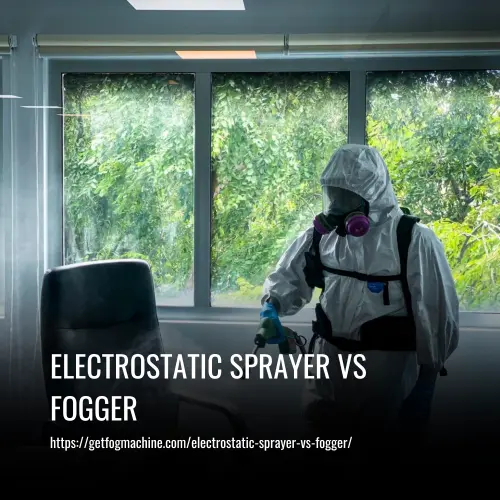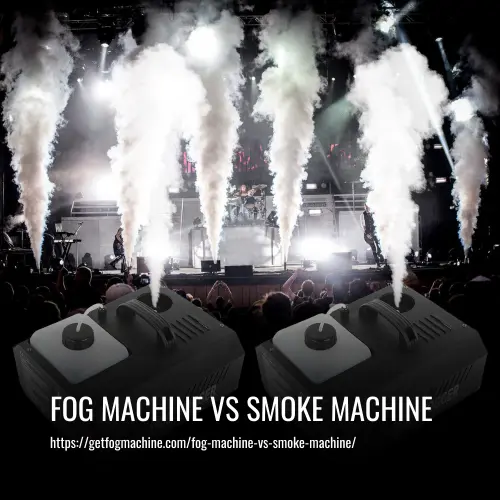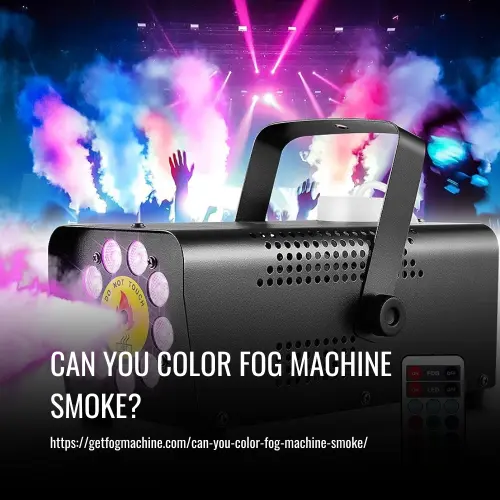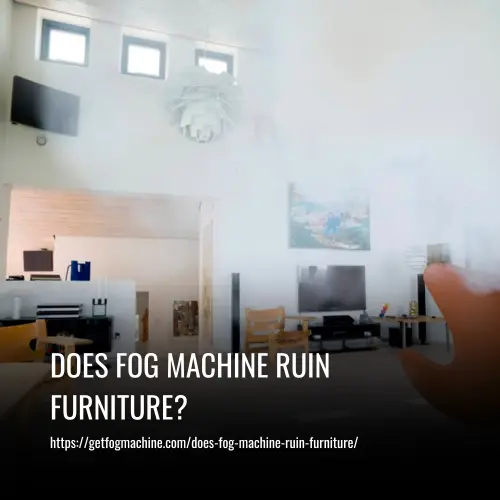Electrostatic Sprayer vs Fogger: What are the Differences
This post contains affiliate links. As an Amazon Associate, we earn from qualifying purchases.
Electrostatic sprayers and foggers are both effective tools for disinfection, but electrostatic sprayers are often preferred due to their lower cost compared to foggers. Foggers are particularly useful for sanitizing large areas and can also be used for other purposes like creating special effects at events.
On the other hand, electrostatic sprayers use electrical charges to evenly distribute disinfectant droplets, ensuring better coverage and contact time on surfaces. This makes them ideal for disinfecting indoor environments, which are prone to the spread of viruses on surfaces.
Ultimately, the choice between an electrostatic sprayer and a fogger depends on the specific needs and budget of each user.

What is an Electrostatic Sprayer
Electrostatic sprayers are devices used to apply sanitizers and disinfectants onto surfaces. These devices utilize electricity-based technology to generate charged droplets that actively seek out environmental surfaces to stick to and wrap around. This results in a uniform coating of sanitizer or disinfectant on surfaces, even in hard-to-reach areas where manual cleaning is not effective.
Electrostatic sprayers distribute liquids as a fine mist, avoiding pooling and using less product, making them cost-effective and efficient. They are particularly useful for areas with intricate spaces, bulky furniture, or heavy objects that are difficult to lift or reach underneath.
How Does Electrostatic Spraying Work
Electrostatic spraying is a technique for applying a very thorough and even coating of a disinfectant or sanitizer to a variety of surfaces and objects. When a solution is sprayed through the device, an electric charge is applied to the solution, resulting in a wrapping effect being created.
This process allows the positively charged particles in the spray to evenly coat all types of surfaces, achieving complete coverage. The electrostatic spray not only disinfects the surface it is pointed at but also wraps around objects, ensuring a more thorough and effective application of the disinfectant on all surfaces and objects.
Advantages And Disadvantages of Electrostatic Sprayers
Electrostatic sprayers offer several advantages and disadvantages when it comes to disinfecting surfaces.
The Advantages of Electrostatic Sprayers
Here are Some Advantages of Electrostatic sprayers.
1. No Hard-To-Reach Surfaces
Electrostatic sprayers can effectively disinfect even hard-to-reach or irregular surfaces. The electrostatic charge applied to the disinfectant solution causes it to adhere to surfaces evenly, including areas that are difficult to reach manually. This makes electrostatic sprayers ideal for spaces with intricate furniture or objects that are challenging to move or reach underneath.
2. Product Savings
Using an electrostatic sprayer allows for efficient distribution of the disinfectant solution in the form of a fine mist. This results in less product usage compared to traditional spraying methods. As a result, companies can save on both product costs and labor expenses while reducing chemical waste.
3. Brief Waiting Periods
The electrostatic sprayer delivers the disinfectant solution quickly, minimizing contact time with surfaces. This reduces the risk of the disinfectant pooling on surfaces and objects. As soon as the solution has dried, which often takes just a few minutes, occupants can safely re-enter the area without significant interruption.
The Disadvantages of Electrostatic Sprayers
Here are Some Disadvantages of Electrostatic sprayers.
1. More Room for Human Error
There is a possibility of human error when using electrostatic sprayers. Crew members may get distracted or forget which surfaces they have already treated, potentially leading to unsanitized areas or wasted time and product in re-treating spaces.
2. Potentially More Time Consuming
Operating an electrostatic sprayer requires the presence of a crew member and cannot be left to work independently. Each surface must be sprayed to ensure thorough disinfection, which can be time-consuming, especially in large rooms. Refilling handheld sprayers with limited capacity may also contribute to time delays.
3. Not All Surface Types Are Suitable
While most surfaces possess a negative charge that is receptive to the positively charged disinfectant solution from electrostatic sprayers, some surfaces may not have a negative charge or may be made of insulating materials. In these cases, the expected results from electrostatic spraying may not be achieved.
When to Use Electrostatic Spraying
Electrostatic spraying is specifically designed for high-touch disinfection and sanitization situations. It is ideal for use on touchpoint surfaces, such as door handles, light switches, and countertops, where there is a higher risk of contamination.
Electrostatic spraying provides a thorough and even layer of disinfectant, thanks to the electrical charge applied to the droplets. This method not only saves time by quickly covering large areas but also reduces the amount of disinfectant solution required compared to traditional trigger spray application.
Its enclosed system ensures better containment and prevents overspray, which is especially important in indoor environments.
What is a Fogger
A fogger is a device that generates fog, which is a mist-like substance that doesn’t wet or soak surfaces like traditional sprays would. The fog produced by foggers is similar to natural outdoor fog and is much airier, causing only a slight increase in humidity.
Foggers are commonly used to eliminate airborne pathogens and disinfect moisture-sensitive items such as electronics. They come in various sizes and configurations, including compact, handheld, and wall-mounted options.
When paired with high-quality disinfectants, foggers provide complete disinfection of spaces, making them an effective tool for combating germs and pests. Opting for environmentally friendly and all-natural disinfectants is recommended to ensure the safety of people, pets, and plants.
Advantages And Disadvantages of Foggers
Foggers have gained popularity during the COVID-19 pandemic as effective tools for disinfection. However, like any other technology, they come with their own set of pros and cons.
The Advantages of Foggers
Here are Some Advantages of Foggers.
1. Air Disinfection
Foggers excel in eliminating airborne pathogens, ensuring comprehensive disinfection of the air, surfaces, and objects in a room. This top-to-bottom cleaning approach is especially crucial in healthcare settings where complete disinfection is critical.
2. Variety of Options
There are different types of foggers available to suit varying needs. Hand-held foggers offer the best coverage, but they require substantial personal protective equipment (PPE) due to the risk of inhaling disinfectant. Single-use foggers, on the other hand, provide a practical alternative. They can be placed in a room, activated by pulling a tab, and left to do their job independently.
The Disadvantages of Foggers
Here are Some Disadvantages of Foggers.
1. Uneven Coverage
One drawback of foggers is that the disinfectant droplets may not land evenly on surfaces, potentially leading to spotty coverage. To mitigate this issue, it is recommended to close doors and windows and turn off fans to reduce air circulation, allowing the disinfectant to settle more evenly.
2. Longer Wait Times
Depending on the type of fogger used, the disinfection process may take anywhere from one to four hours. This extended wait time is necessary to ensure the complete deposition of disinfectant and to allow for safe re-entry into the space.
When to Use Fogger
When disinfection is required in large open spaces, fogging is the best option due to its ability to quickly and effectively cover a wide area. Fogging allows the disinfectant solution to be sprayed up to 15 meters or further, reaching all the hard-to-reach areas.
This makes it especially useful in the event of a virus outbreak in a facility, as it can be implemented quickly to help stop the spread of the virus. However, it is important to note that fogging should be considered part of the cleaning process, and additional safety measures such as protective gear and downtime may be required after fogging has been completed.
Is a Fogger the Same as an Electrostatic Sprayer
No, a fogger is not the same as an electrostatic sprayer. While foggers create a dry or cold fog that kills pathogens in the air and on surfaces they contact, electrostatic sprayers use an electrode to introduce a positive electric charge to a disinfectant solution.
This charge allows the solution to attach to surfaces and objects, ensuring complete coverage. Both foggers and electrostatic sprayers are effective tools for disinfection, but the choice between the two depends on factors such as the space, traffic, furniture, and materials that need to be disinfected.
Do Fogging And Spraying Have Different Purposes
Fogging and spraying are two different methods of disinfection, each with their own distinct purposes and advantages.
Fogging is a “dry” method of disinfection that utilizes machines to create tiny particles that can float in the air. This allows for the easy and efficient disinfection of entire rooms. However, it is important not to enter the room while fogging is taking place in order to avoid inhaling the disinfectant particles.
On the other hand, spraying surfaces with an electrostatic sprayer ensures even and precise coverage of the disinfectant solution. This method is particularly effective for complex surfaces and areas that cannot be easily accessed by fogging machines. The electrostatic sprayer applies a negative charge to the disinfectant solution, causing it to adhere to surfaces more effectively.
One key difference between fogging and spraying is the size of the particles. Spraying requires very small particles to effectively cover surfaces while fogging utilizes even smaller particles that remain airborne rather than wetting surfaces.
Choosing Between Electrostatic Sprayers and Foggers
Choosing between electrostatic sprayers and foggers depends on the specific needs of the space being cleaned. In rooms with minimal furniture, both options can deliver similar disinfection results. However, when dealing with rooms that have numerous objects or complex shapes, electrostatic sprayers are better suited as they provide precise and uniform coverage.
On the other hand, if disinfection is not frequently requested or if there are concerns about the safety of cleaning crews, a single-use fogger may be a more practical choice. It is important to carefully consider the needs of clients and the abilities of the cleaning crews before investing in new equipment.
Factors to Consider Before Choosing Electrostatic Spraying or Fogging
Before deciding whether to use electrostatic spraying or fogging for disinfection, there are several important factors to consider. Each method has its own advantages and considerations that may impact the effectiveness and safety of the disinfection process.
1. Wet vs. Dry Disinfection
Electrostatic spraying involves the application of a disinfectant solution in a wet form. This method requires careful consideration of any electronic equipment in the area being treated. On the other hand, fogging is a dry disinfection method that allows electronics to remain in the room during the treatment process.
2. Electrostatic Spraying
When using an electrostatic sprayer, the disinfectant droplets are given an electric charge. This charge causes the droplets to become naturally attracted to surfaces being sprayed, resulting in more uniform coverage. The droplet sizes range from approximately 50 to 100 nanometers, allowing for efficient coverage and minimal wasteful overspray.
3. Contact Time and Occupancy
One advantage of electrostatic spraying is that surfaces typically dry within 15 minutes, minimizing occupancy delays. However, it is important to ensure that the required contact time for effective disinfection is achieved. The contact time may vary depending on the disinfectant being used, and it is necessary to follow the instructions specified by the disinfectant manufacturer.
4. Disinfectant Selection
The choice of disinfectant is crucial for both electrostatic spraying and fogging. Consider factors such as the disinfectant’s efficacy against specific pathogens, its compatibility with the equipment and surfaces being treated, and adherence to any specific disinfectant concentration or label requirements.
5. Safety Considerations
Both methods require careful attention to safety protocols, including proper ventilation, personal protective equipment (PPE), and adherence to recommended guidelines. It is essential to select a disinfectant that is safe for use in the intended environment and to follow all safety instructions provided by the disinfectant manufacturer.
Why Electrostatic Spraying Is Better Than Fogging
Electrostatic spraying is a highly effective method of disinfection that offers several advantages over fogging. Here’s why electrostatic spraying is better:
1. User Control
With electrostatic spraying, the user has complete control over the process from start to finish. The user can work from different angles and ensure that all areas of a room are properly treated. In contrast, fogging relies solely on a machine to distribute the disinfectant, which may result in missed areas due to a lack of user presence.
2. Adjustable Volume
Electrostatic sprayers allow the user to adjust the volume of the disinfectant spray. This precision control helps optimize the amount of disinfectant used, reducing the cost and waste associated with excessive liquid usage in fogging.
3. Minimal Downtime
Electrostatic spraying requires less downtime compared to fogging. After a room has been electrostatically cleaned and dried, it can be re-entered immediately without removing the electrostatic spray. In contrast, fogging may require a longer waiting period before the environment can be accessed again.
4. Effective and Efficient
Electrostatic spraying ensures effective and efficient disinfection. The electrostatic charge applied to the disinfectant creates a magnetic attraction to surfaces, allowing the spray to reach hidden and shadowed areas. This comprehensive coverage significantly reduces the chances of missed spots, unlike fogging where some surfaces may not be adequately treated.
Which Type Of Electrostatic Sprayer Is Best For Your Facility’s Needs
When it comes to choosing the best type of electrostatic sprayer for your facility’s needs, there are a few factors to consider. These include the size of your facility, the type of surfaces you need to clean and disinfect, and your budget. Consulting with a reputable dealer or manufacturer can help you make an informed decision.
Types of Electrostatic Sprayers
1. Air-Assisted Electrostatic Sprayers
These sprayers use compressed air to evenly distribute the disinfectant solution over surfaces. The air assistance helps to create a fine mist of droplets, ensuring thorough coverage.
2. Electrostatic Precipitators
These sprayers utilize an electrical field to charge the particles in the solution, which are then attracted to the surface being treated. This method provides precise and targeted application.
3. Corona Discharge Electrostatic Sprayers
This type of sprayer employs a high-voltage electrode to create an electrical field that charges the particles in the disinfectant solution. The charged particles are then attracted to surfaces, guaranteeing effective coverage.
4. Ionic Air Purifiers
While not strictly electrostatic sprayers, ionic air purifiers can also be used for disinfection purposes. They use an electrical field to charge particles in the air, which are then attracted to the surface of the purifier. This helps to remove contaminants from the air and surfaces.
5. Ultrasonic Humidifiers
These sprayers employ high-frequency sound waves to create a mist of water droplets that can evenly distribute the disinfectant solution over surfaces. While primarily used for humidification, they can also aid in the application of disinfectants.
FAQs
Electrostatic sprayers are devices that use an electric field to cause a charged particle to move in a specific direction. These sprayers are commonly used for disinfectant application, as they ensure even distribution of the disinfectant solution over the surface being treated.
Electrostatic sprayers are highly effective for disinfectant application. They not only ensure even distribution of the disinfectant solution but also reduce the time needed for the application. Additionally, they can help improve indoor air quality.
The duration of electrostatic spraying depends on factors like the size of the space, the products used, and environmental conditions such as humidity. In high humidity environments, electrostatic spraying dissipates more quickly. The solubility and size of the disinfectant particles being sprayed also affect how long they stay airborne.
An electrostatic fogger is a device that uses an electrical charge to create a fine mist of solution for disinfecting or cleaning. Unlike electrostatic sprayers, foggers create a fog or mist rather than a stream of solution.
Hiring a professional service for electrostatic spraying is advantageous because they have the experience, knowledge, equipment, and supplies to ensure proper cleaning and disinfection. They can help save time and money in the long run.
Electrostatic sprayers provide more complete coverage compared to manual spraying, reach hard-to-reach places, use less solution, and speed up the cleaning and disinfecting process.
Despite the benefits, there are drawbacks to using electrostatic sprayers. They require a higher initial investment, can be challenging to use in small spaces, and may cause solution waste if not used properly.
Electrostatic sprayer testing is the process of verifying that a particular sprayer is working properly and can achieve the desired results. This involves testing the sprayer’s ability to atomize and evenly apply a liquid. It can be done by spraying water onto a charged plate or spraying paint onto a surface.
Conclusion
Whether you choose an electrostatic sprayer or a fogger, both options have their advantages and can be effective in disinfecting and sanitizing spaces. It ultimately comes down to your specific needs and preferences.
Whichever option you go with, investing in advanced technology like this will undoubtedly help in maintaining a clean and safe environment.
So, go ahead and make the right choice for your business or home – and enjoy the peace of mind that comes with a thoroughly sanitized space.






